“Fusionman” ditches during Africa-Europe flight
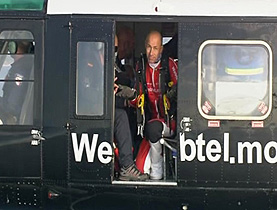
Yves "Fusionman" Rossy ditched safely into the freezing Atlantic waters on Wednesday while trying to fly between North Africa and Europe using his DIY jetwing.
Rossy, an airline captain and ex-fighter pilot, took off from Tangiers for southern Spain but around four minutes into an expected 15-minute flight ditched into the water after encountering heavy turbulence and visibility problems.
“I’m a little disappointed as I wanted to reach my goal – that beach,” Rossy told a press conference in the Spanish resort of Atlanterra after his failed flight.”But it’s part of the game. My Plan B functioned and I’m ready to go again.”
Everything seemed to be going so well when the Swiss daredevil leapt from a small plane 2,000m over Tangiers at 3.05pm with his two-metre wide homemade wing strapped to his back, the four jets already ignited.
While in freefall he opened the Kevlar wing to its full extent, with a twist of a throttle powered up the jets and then shot towards the rugged Andalusian coastline.
But even the best-laid plans can go awry. Within minutes he disappeared from sight, lost in thick, “beautiful” clouds which were “bigger than expected”.
“I wanted to go over them but I was too slow,” Rossy explained.
Shaken violently by the turbulence, Rossy dropped to try to regain control, but suddenly lost his bearings inside large grey clouds.
“My only instruments are my feelings and sight and without them I am lost,” he said.
“No more fun”
Rocketing seawards at 300km/h, Rossy realised “it was no more fun”, ditched his wing and pulled his parachute 850m above the sea.
“I’ve had many situations like that in the free air but not in clouds. Ninety per cent of the time I can regain control, but in those clouds it was over,” he added.
As his team and camera crews peered into the gloom anxiously, a rescue party of three helicopters, two planes and ships from the Spanish coastguard struggled for ten minutes to locate Rossy.
A homing beacon on his Breitling watch and bright parachute helped indicate his precise location in the chilly waters.
He was then taken to a hospital in nearby Jerez de La Frontera for a precautionary check-up but returned to Atlanterra unhurt and in “good spirits”.
Brave face
The flight was broadcast live for Webtel.mobi, a mobile phone company that has funded the stunt. Its CEO Stuart Sterzel put a brave face on things.
“No, he didn’t make it but, yes, it was a success because it was man’s first attempt,” he told journalists.
“If man has the courage to attempt something like this, that is what is important. If it’s the first attempt, then perfect,” Sterzel added.
“The window is closed now for a couple of months but he’ll be back again. Probably early in the new year.”
The Swiss birdman agreed: “I’m confident that next time it will be good with a better wing and better weather.”
Rossy’s teammate Stephane Marmier, who was monitoring local weather conditions in Atlanterra, let out a huge sigh of relief to know that Rossy was alive.
“I’m now more relaxed to know that he’s OK,” Marmier said. “It wasn’t easy finding him in the ocean. But it’s life; it’s part of his training – this kind of thing just makes you stronger.”
“I know I’m a bit on the edge and it’s a new domain so you make mistakes, but you learn from them. That’s how you improve your performance,” Rossy agreed.
Record-breaker
The Swiss daredevil has made a number of successful record-breaking attempts in the past.
He rocketed into the record books in September 2008 when he became the first person to fly solo across the English Channel using a single jet-propelled wing.
He trained hard for the intercontinental challenge from August this year, making a dozen practice flights near Bex in canton Vaud with the same long-distance wing he used for the Calais-Dover crossing.
Despite this setback, Rossy is continuing with his plans to fly over the Grand Canyon in April 2010.
While on his three-year sabbatical from his commercial airline pilot job, he has been developing two smaller, simpler, high performance prototype wings with much more power to perform aerobatics.
He is also developing a new parachute that he could open safely at 200m rather than the current height of 800m.
“It’s impressive,” said Marmier, who has been helping Rossy test the new wings. “He can do loops and new moves. It’s really difficult to follow him now.”
Rossy says he wants to explore the wing’s full potential.
“It’s such a great feeling when you are flying like that,” he said. “You are near a dream. The emotions are so strong, you become addicted.”
Simon Bradley in Atlanterra, swissinfo.ch
Yves Rossy, aka Fusionman, was born on August 27, 1959 in Neuchâtel, Switzerland.
He has worked for the past ten years as a commercial pilot for the airline company, Swiss. Prior to that, he worked for 15 years as a fighter pilot for the Swiss Air Force.
An accomplished sportsman, his past and present hobbies include surfing, water-skiing, wakeboarding, parachuting, aerobatics, motorbike riding, rafting and hang-gliding.
He has long been involved in flying adventures. He is a keen sky surfer – performing aerial stunts on a board after freefalling from a plane – and was the first to sky surf from a hot air balloon.
Another Guinness record comes from being the first person to be transported between two small planes while holding onto handles on the wingtips of each plane.
Rossy zoomed into the record books on June 24, 2004 by becoming the first person to fly horizontally for four minutes with a jet-propelled wing strapped to his back.
On September 26, 2008 Rossy became the first person to fly solo across the English Channel using a single jet-propelled wing, retracing the route of French aviator Louis Blériot.
Rossy’s transformation from human to jet-man involves putting on a Formula-1 fireproof suit, three parachutes, two for Rossy and one for his wing, a helmet that beeps a warning when he goes too low and his homemade three-metre-wide carbon wing, which is strapped to his back and powered by four mini jets. His invention weighs about 55kg with fuel.
The wing, which he conceived, built and fine tuned himself over eight years, has no steering capability so Rossy had to control his movement using his head, shoulders and arms. The only instrument is the fuel throttle.
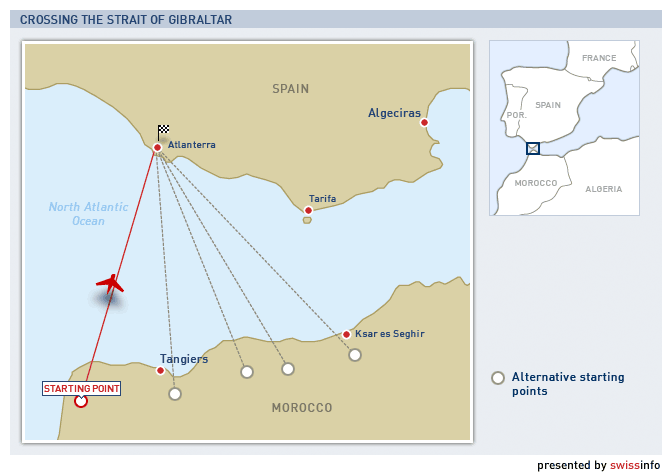

In compliance with the JTI standards
More: SWI swissinfo.ch certified by the Journalism Trust Initiative

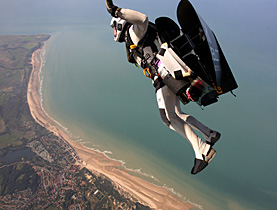
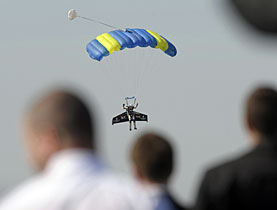
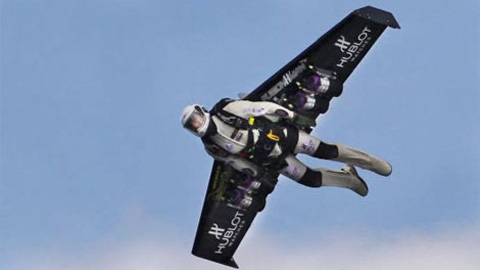
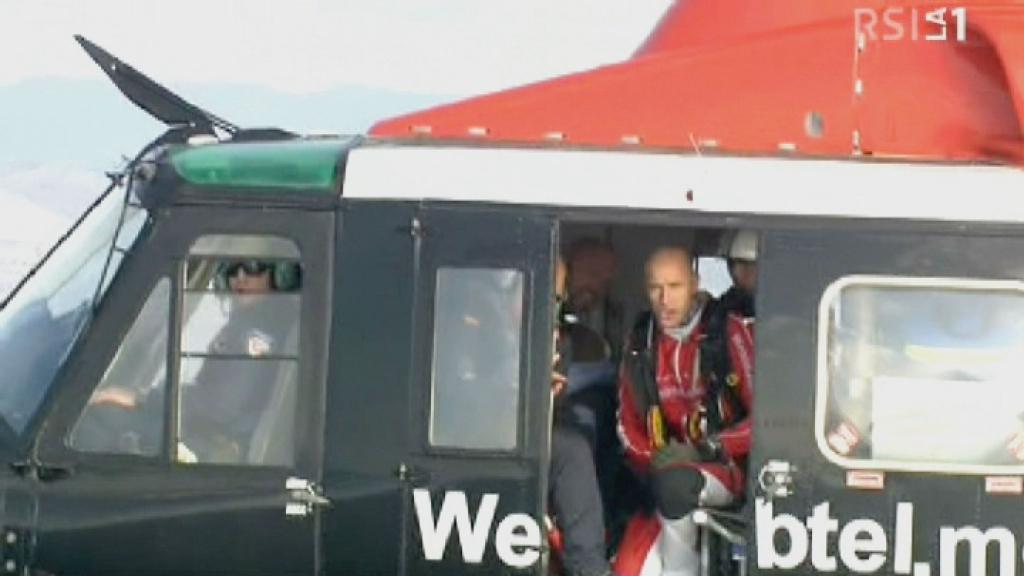
You can find an overview of ongoing debates with our journalists here. Please join us!
If you want to start a conversation about a topic raised in this article or want to report factual errors, email us at english@swissinfo.ch.